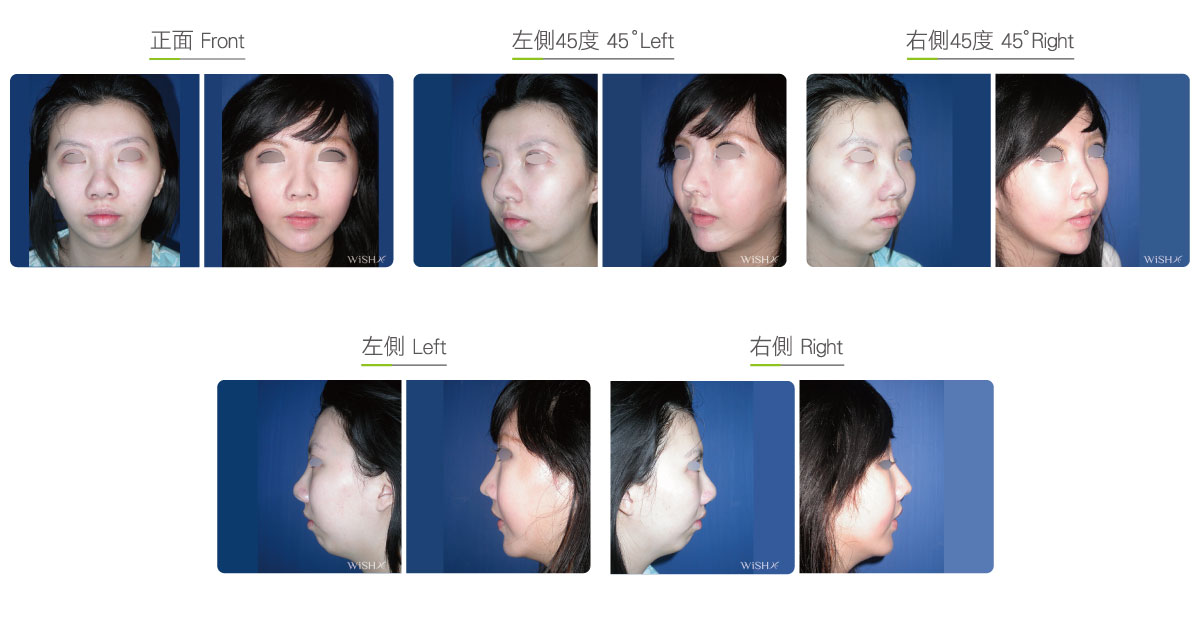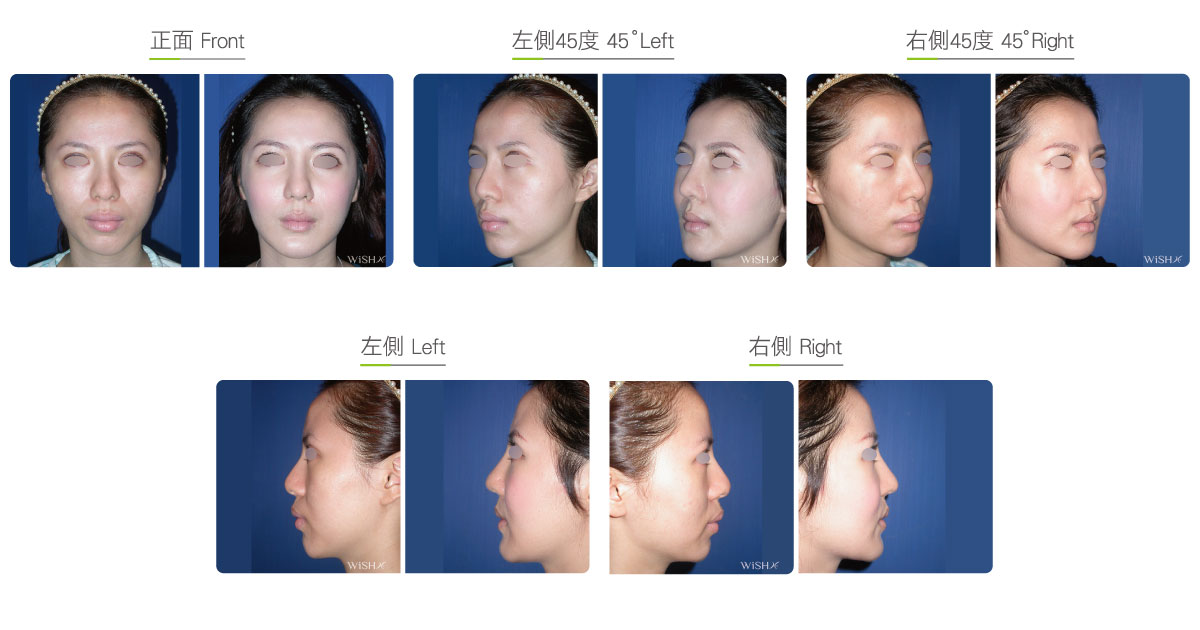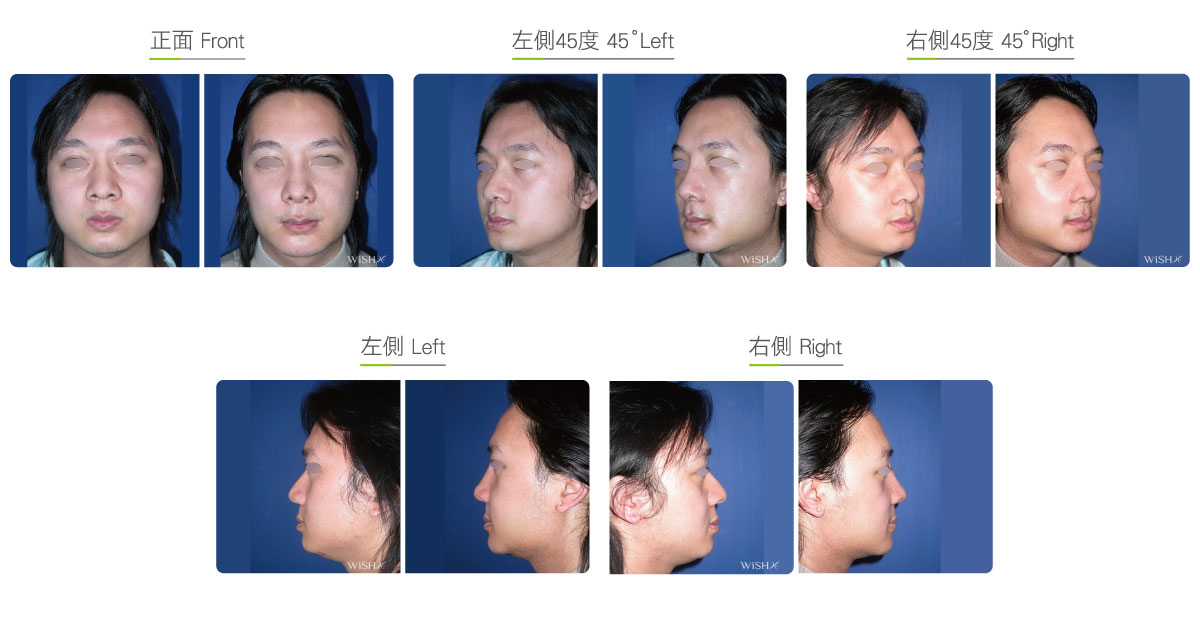Composite Facial Conversion
The face is made of hard structures (such as the skeleton, cartilage, alveoli, and nose bridge) and soft tissues (such as the skin, fats, muscles, and nerves). Hard structures determine the overall facial contour and stereoscopic impression and play a decisive role in the esthetics of appearance, while soft tissues attached to hard structures have complementary functions of decorating and optimizing the skeleton and relevant structures, which are critical to the proportion and delicateness of the facial sense organs. Therefore, the evaluation of facial plastic surgery should take into full account the relative relationship and characteristics of both main structures to effectively resolve and fix the problems of patients.
Considering the attachment relationship of the skeleton to the skin and facial sense organs, Dr. Chuang advocates that plastic surgery procedures should start from hard structures, a critical factor of contour proportion, and then deal with soft tissue problems in a step-by-step manner. Nevertheless, some patients who requirements to change multiple sites of the face or facial sense organs are unable to accept the prolonged recovery and waiting times of separate surgeries and hope to achieve whole face remodeling in one surgery; thus, sculpting a well-proportionate and esthetic face meeting patients’ expectations entails comprehensive and detailed preoperative planning, close cooperation of the surgical team, and most importantly sufficient communication between patients and physicians.
Because this composite facial conversion involves hard structures and soft tissues and renders obvious changes, Dr. Chuang first fully listens to patients’ expectations, and after confirming the surgical contents and sites, he schedules necessary examinations such as skull X-rays, CT imaging in light of surgical characteristics, or additional 3D preoperative simulation imaging for those with special requirements to allow patients having a basic idea of the possible results after surgery. In this way, it shortens postoperative adaptation issues and alleviates agitation during recovery. All the srgical contents should be decided based on patients’ requirements and mostly include the following options:
- Skeleton reduction: cheekbone reduction, mandible reduction, chin reduction (genioplasty), V-shape mandible reduction (V-line bone contouring)
- Facial implant emplacement: cheekbone implant (malar and submalar triangle augmentation), paranasal augmentation (nasolabial groove correction), chin augmentation, forehead/brow implant augmentation, mandible implant
- Facial sense organ plastic surgery: open (Korean-style) rhinoplasty, double eyelid surgery, medial or later canthoplasty, eye bag removal
- Skin tightening surgery (facelift): endoscopic forehead or midface lift with Endotine fixation, midface temporal lift, regional jawline lift
The aforementioned surgical options and combinations are highly customizable and meet the different requirements of patients. Dr. Chuang needs to schedule the sequence of the surgery in light of the characteristics to ensure correct intraoperative judgment and comprehensive presentation of results. Dr. Chuang upholds that the surgery should start from sites prone to be affected by swelling (such as the double eyelids or eye bag removal), followed by bone reduction, facial implant augmentation, rhinoplasty, and skin tightening and lift. Because such holistic surgeries necessitate strong coordinated esthetics, Dr. Chuang performs each procedure himself, which, combined with advanced devices and the presence of a qualified anesthetist, offer the guarantee of the highest standard surgical safety and results.
The great advantage of the surgery is the completion of multiple site changes in one surgery, saving the prolonged recovery and waiting periods of separate surgeries in traditional concept. It thus allows patients to achieve face remodeling in the shortest time. The disadvantage is the high complexity of the surgery that needs to be completed by an experienced physician and team and the relatively prolong postoperative swelling and recovery periods due to the long surgical time as well as the higher risks of wound healing or infection that require patients to pay more attention to wound caring to prevent any probable complications. Moreover, such a surgery causes distinct changes in the original face shape and facial sense organ features that make their appearance unlike that of other family members, so patients should prepare themselves psychologically before the operation to prevent any self-identification disorder as it is impossible to restore the original appearance after surgery.
Surgical conditions
Duration
- Type of anesthesia: General anesthesia
- Type of incision: Dependent on surgical sites
- Recovery: 10–14 days
- Removal of stitches: 10–14 days
General instructions
No food and water on the day of surgery
- Fast from food and water for 8 h preoperatively on the day of operation.
- Avoid smoking for 1 month preoperatively.
- Avoid smoking, alcohol, and irritating foods for 1 month postoperatively, and avoid strenuous or excessive activities
- Avoid raw food or seafood for 2 months postoperatively
- Avoid heavy massage to or squeezing of the face for 3 months postoperatively.
Ideal candidates
- Patients with subjective requirements of whole face change
- Those unsatisfied with multiple sites of their congenital facial appearance
- Those who hope to achieve a distinct facial contour or facial sense organ changes in one surgery
- Those who need to undergo reconstruction of extensive facial defects due to prior surgery or trauma
- Those who need to undergo plastic surgery and correction of multiple sites due to congenitally obvious unequal faces or facial sense organ development
- Those who need to undergo transgender facial conversions due to sex identification disorders
- Those who have undergone several facial plastic surgeries but show poor results
- Those who hope to have a face shape similar to that of a celebrity or star
Possible complications
- Scar proliferation
- Prosthesis reaction or infection
- Cheek rigidity or numbness
- Ppoor wound healing
- Bone loss
- Skin laxity
Surgical advantages
-
One surgery achieves multiple improvements and presents obvious results of face change.
-
It lowers the risks of traditional separate surgeries and curtails the waiting period.
-
It customizes the facial sense organs and bone contour expected by patients.
-
The surgery is conducted by one physician. This avoids the esthetic and surgical conflicts by different hands.
Surgical drawbacks
-
The surgery takes much time, and postoperative swelling subsidence and recovery are slow.
-
The risks of postoperative wound healing or infection are higher than those from a single surgery.
-
Patients should have full confidence in the esthetics and skills of the surgeon.
-
Self-identification disorder or mental adaptation problems may occur after the operation.
-
A new photo may be needed to take for an ID card or any certificates.
-
If a patient is unaccustomed to surgical results, it is difficult to restore the complete original appearance.





